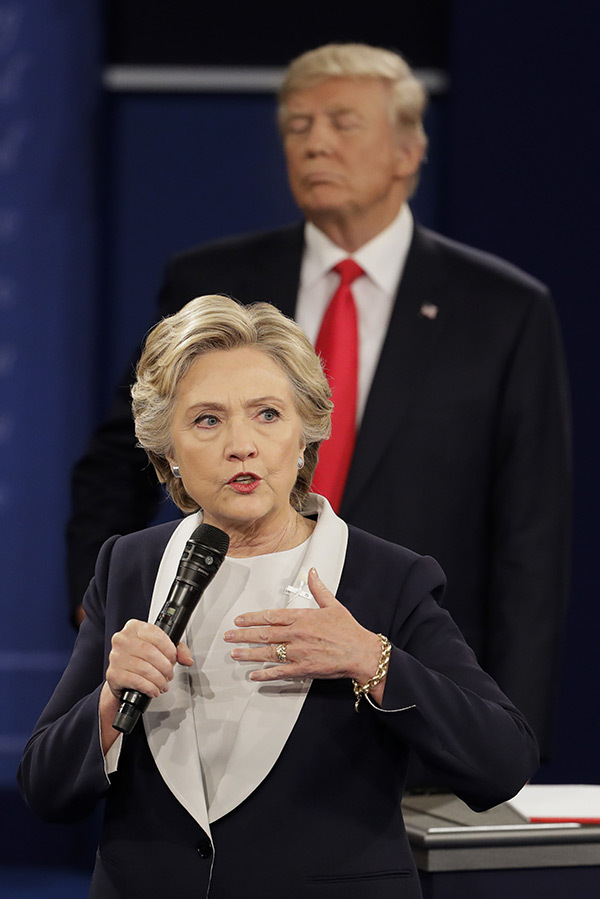The second U.S. Presidential Debate between Donald Trump and Hillary Clinton, which aired on October 10, 2016, was less about verbal exchanges or barbs and more about nonverbal (or silent) language. Trump and Clinton both revealed their attitudes through nonverbal language. Here’s what stood out to me:
No opening handshake. The media repeatedly described this behavior as “unprecedented.” I agree. Even when you dislike or disagree with an opponent, you still extend the courtesy of a handshake. Knowing what had transpired in the media leading up to the second debate, we can certainly understand why there was no handshake. I am surprised that no one in the media mentioned how honest this gesture was. It revealed deeper emotions.
Trump’s dominant, invasive physical stance. Throughout the debate, Trump physically stood close to Clinton while she answered audience questions, sometimes standing right behind her, invading her personal space on the platform. The media (and women, I might add) picked up on this right away. Words like “stalking” have been used in media reports. In a professional arena, such as a debate platform, candidates follow certain protocols or extend courtesies to one another. Candidates have their own designated seated areas. While they are allowed to walk to any part of the platform, they remain mindful of their opponent’s physical position. Trump continued to break protocol. He also wandered and paced the platform while Clinton responded to audience questions, which could be interpreted as a lack of respect or a lack of engagement.
Clinton’s appropriate use of the platform. Clinton came closer to audience members when answering questions, creating an intimate space for dialogue. She followed platform protocol and did not invade Trump’s physical space at any time.
![]() Trump’s lack of control over facial expressions. Trump’s visible facial expressions included pursed lips, pouting, furrowed brows, rolling of the eyes, and finger pointing. His nonverbal behavior can be summed up in one phrase: arrogant bullying.
Trump’s lack of control over facial expressions. Trump’s visible facial expressions included pursed lips, pouting, furrowed brows, rolling of the eyes, and finger pointing. His nonverbal behavior can be summed up in one phrase: arrogant bullying.
![]() Clinton’s smiling during Trump’s negative attacks. Hillary Clinton demonstrated significant restraint during Trump’s repeated verbal assaults. I would have loved to have asked Clinton, “Penny for your thoughts” during those moments. Never before has a politician’s nonverbal language been scrutinized as much as Hillary Clinton’s. When she doesn’t smile, media advisors say she needs to smile more. When she does smile, advisors say she needs to tone down the smiling. It seems that no matter what she does, it’s just not right. I thought she handled Trump’s assaults with grace and professionalism. Some people may have perceived her smiles as artificial, however, I felt she used smiling as a way to remain positive in her remarks.
Clinton’s smiling during Trump’s negative attacks. Hillary Clinton demonstrated significant restraint during Trump’s repeated verbal assaults. I would have loved to have asked Clinton, “Penny for your thoughts” during those moments. Never before has a politician’s nonverbal language been scrutinized as much as Hillary Clinton’s. When she doesn’t smile, media advisors say she needs to smile more. When she does smile, advisors say she needs to tone down the smiling. It seems that no matter what she does, it’s just not right. I thought she handled Trump’s assaults with grace and professionalism. Some people may have perceived her smiles as artificial, however, I felt she used smiling as a way to remain positive in her remarks.
Closing handshake. Well, despite the unprecedented lack of a handshake at the beginning of the debate, the Presidential candidates enjoyed a closing handshake at the end of the debate. Was it because they felt all warm and fuzzy from the closing question, which asked each candidate to say something positive about the other? Hmmm…..Change of heart or following protocol?
Unfortunately, I don’t have the capability of reviewing Trump’s or Clinton’s micro expressions using slow-motion replay technology. Psychologist Dr. Paul Ekman co-discovered the phrase micro expressions. These brief facial expressions (lasting just 1/15 to 1/25 of a second), can reveal a deeper or masked truth about a person’s attitude or behavior. Examples include quick raising of the corner of the lips, expanding or contracting of the iris, narrowing or opening of the eyes, etc. Ekman’s work became the basis for a FOX television program, Lie to Me, which ran three seasons, 2009-2011. A short Guide to Reading Micro Expressions may prove helpful in deciphering the facial expressions during this second debate.
The lesson: Become aware of your nonverbal language because it speaks volumes about who you are as a person and who you are as a professional. Are you presenting yourself well through your nonverbal language?

